#times of india classified booking
Text
Unlock Your Reach: Booking Classified Ads in The Times of India

#times of india classifieds#times of india classified ad booking#book times of india classified ad#ad in times of india#advertise on times of india newspaper#times of india ad#times of india ads#times of india advertisement#times of india classified#times of india classified ads
0 notes
Text
Maximising Your Advertising Budget with Discounts in Times of India. Times of India Ad Cost.

#times classified ad cost#times of india ad cost#times of india advertisement ad cost#ad in times of india#times of india ad booking#book ad in times of india#times of india ad
0 notes
Text
Out Of Your Comfort Zone
masterlist
note: the original ask said fantasy but i dont read fantasy at all, so i went with a silly little romance novel i loved, which i think still displays that opposite thing the anon wanted. so i hope this is okay!!
warnings: my writing while i'm high (rambling that can be disguised as descriptive writing)
word count: 1.2 k
♡ summary: During a bookstore date Y/n's taste in books gets Spencer out of his comfort zone.
♡ Spencer Reid x fem!reader
request ✓




Finally, Spencer had a weekend off, where there was no chance of a case coming in at the last minute. And it’s not like Y/n hated Spencer’s job, she knew he did a lot of good. But it was hard sometimes when they would go a few weeks without sleeping next to each other.
It was the perfect morning to their perfect day, they had just come from a local art exhibit pop-up/farmers market. It reminded Y/n of Notting Hill, of course from the movie but also from when she lived in London while studying abroad. But now the couple was off to the local bookstore, they had looked at the farmers market, but they were all travel books, the irony was not lost.
Them both loving books was what got them to the second date, their first being filled with a debate about ‘modern classics’ and what classifies them. A topic they both clearly had a lot of opinions on as it took up the whole date that they hadn’t asked all the first date questions, so they needed the second date.
Them both loving books was what got them to the second date, their first being filled with a debate about ‘modern classics’ and what classifies them. A topic they both clearly had a lot of opinions on as it took up the whole date that they hadn’t asked all the first date questions, so they needed the second date.
And though their taste in books were quite opposite, there was a small overlap that was home to Little Women, Pride and Prejudice, The Bell Jar, and many others. But that was Spencer’s main area, classics, Y/n only read the feminist classics.
So when they went to the bookshop, the two would split up until Spencer finished looking in his favourite sections, since he could read so much faster than the girl it took her about three times as long to look through the fiction section.
Spencer was making his way to her now, stopping to read the backs of a couple books that interested him, even picking one up to buy. He walked past the isles of the fiction and romance sections, finally coming to a halt at the ‘J’s where Y/n was now. She didn’t even register his presence, too wrapped up in reading the summary of the blue and yellow book in her hand.
Spencer didn’t want to startle the girl, so he walked past her, her eyes rising from the book in hand to look at who she thought was a random person just browsing the store like her, eyes lighting up when she sees it’s Spencer.
“Honey, what’d you find?” She questions, Spencer assumes it was a rhetorical question since she didn’t give him enough time before she cuts in grabbing the second book from the stack in his arms, “I was gonna suggest this one to you! A subscriber said it was really good!”
Y/n was a booktuber, when she told Spencer that he obviously had no idea what that was, but a simple explanation later and he was caught up. And after a year of dating, she finally mentioned him in a video when she was talking about ‘Normal People’ . It was one of the books they argued could be considered a modern classic on their first date. And she mentioned his taste in books and now her followers left recommendations for him in her
comments, mostly on instagram when she posted him from time to time.
“Yeah. I was really impressed with another book by this author, her description of the caste system in India and the impact it has mentally was so moving.” “I remember you reading that. I’m not good at reading those types of books, but I love when you tell me all about them.” Her soft words brought red to Spencer’s checks while he hid his hands around her waist.
Recovering from the girl’s flirting, even after a year he still reacted the same to her words, his head rose from the spot in her neck to look at the book she had been looking at when he found her.
“What did you find?” “Oh, I saw a girl say it was a good book in her review and I want to do a video on age gap books since so many people ask.” Pacing the books over to him when he signalled his hand forward for it, turning it over to read the front, ‘Part of Your Word’ by Abby Jimenez in large letters was written across the front. It wasn’t a fairly large book, it could take him maybe five minutes.
Y/n was now turned to read more titles, stopping at any that caught her eye. All the while, Spencer was stood of to the side reading. It had actually only taken the man four minutes when he checked his watch. Proud of himself, he looks up to see that his girlfriend was apparently watching him, for how long, he didn’t know.
With a smile on his face, he asks, “What?” “Spencer. Did you just read my book? Before I even bought it?” She replied with a hand going to her hip and a jokey tone. “Well, first of all, you aren’t buying it bec-” “Why was it bad?”
Y/n often spoke before thinking, causing her to cut off people, Spencer was used to it he thought it was cute and she always made it her mission to not interrupt when he was really passionate about a topic.
“Because, I’m buying.” “Hon, no you bought last time.” “I don’t mind.” “I do.”
Spencer moved on from this conversation, they both know how it will end. Spencer will in fact pay, Y/n will say he didn’t have to, Spencer would say he doesn’t mind, she’ll say she does mind, and they repeat it when they pay for lunch after the bookshop.
“But I did read it.” “Don’t spoil, but what did you think?” She had watched a couple booktok reviews on it so she knew it was a little spicy, something she knew Spencer didn’t read a lot of, if ever.
“I think it was good. I liked how they talked about family relationships and verbal abuse in relationships, I think it was done well and it brought a lot more sense of realism. And I liked the leads, I relate to Daniel more than I thought, his dedication to making things work.. I won’t spoil it for you but- um yeah. And I liked the setting.”
His words sent a loving smile to rest on the girl’s face, she loved nothing more than to hear Spencer talk. His voice was deep yet not at the same time, and his mannerisms were adorable to her. And hearing him actually read and enjoy a book from the romance section that was written in the last few decades, was a big step for him. He didn’t even know about Twilight when they met.
“I’m glad you like it.” She said, truthfully, “I’ll be sure to mention that in my video.” “You don’t have to.” “You just don’t want Penny to see the video and by extension Derek.”
Their conversation continued while they waited in line, holding each other's hand while Y/n looks up to speak. They were interrupted when it was then their turn, Spencer paying like he said he would, and again at lunch, much to the girl’s disapproval.
“You don’t have to pay.” “I don’t mind.” “I do.”

#spencer reid#spencer reid x reader#spencer reid x fem!reader#spencer reid x fem reader#spencer reid fanfiction#spencer reid fluff#spencer reid fic
135 notes
·
View notes
Text
Resources to learn more about Hinduphobia, and Hindu culture.
Making a masterpost about this because I'm getting a lot of asks for it. The list will be updated!
Books to read:
Not Without My Daughter by Betty Mahmoody. This is the memoir of a woman stuck in Iran and how she has to illegally sneak out with her daughter. It doesn't focus on Hinduphobia but it does highlight the violence perpetuated by Muslims to women. This is a true story and a movie has also been made on it. Also, I just need to appreciate how well it's written, I was on the edge of my seat the whole time.
Aavarna by S. L. Bhyrappa. This book basically details how Hindu history was derailed and destroyed by Mughal invaders, specifically Aurangzeb, the plot is fictional but the history is real.
All Religions Are Not the Same by Sanjay Dixit. This is a new book and I've just ordered it actually. It discusses the differences between religions and how secularism affects that.
Why I Killed Gandhi by Nathuram Godse. Includes the testimonial of the man who killed Gandhi. I'm about to read this book and I'm excited. Don't be fooled by the one-star reviews.
Some people you can follow on Twitter are Dr Anand Ranganathan, The Skin Doctor, and VivanVatsa. They're all well-read on Hinduphobia and/or Hindu history. Anand Ranganathan also has published books on Hinduphobia, like Hindus in Hindu Rashtra.
Blogs you can follow for awareness, and learning about Hinduphobia/Hindu culture:
@rhysaka (debunking common myths, awareness)
@magic-coffee /@vindhyavasini(debunking common myths, awareness, politics/geopolitics, news, culture)
@anjanadri (debunking common myths, awareness, culture)
@latent-thoughts (history and explanations, culture)
@forgotten-bharat (amazing for the history of ancient India, and culture)
@misalpav (culture, awareness)
Interesting masterposts from other blogs:
Booklist to learn more about Hindu History by @magic-coffee
The Ayodhya Masterpost by @magic-coffee
Some important Hindu literature:
Mahabharata
This is classified as an Itihasa text. It deals with a war between 2 royal factions and is a vehicle for describing the activities of the Avatar Krishna.
Ramayana
This is also an Itihasa text. It provides the biography of Lord Rama who is considered an Avatar of Vishnu.
Bhagavad Gita
This is an important text of the Vedanta school and is treated separately although it is part of Mahabharata. It provides a coherent summary of Vedanta.
Srimad Bhagavatam
This is a Purana and provides a biography of Lord Krishna. This is an important text for the Vaishnava sect of Hinduism.
Shiva Purana and Linga Purana
These Puranas provide the biography of Lord Shiva and are important texts for the Saivite sect of Hinduism.
Chandi or Devi Mahatmyam
This is an important text for Saktas who worship Sakti or Devi. This text is really part of the Markandeya Purana.
But really, the best way to combat Hinduphobia, is to learn about our history and culture, because if you know the truth, you won't fall for the twisted narrative being peddled by the media today. If you've got to the end of this, thank you for educating yourself and learning about us.

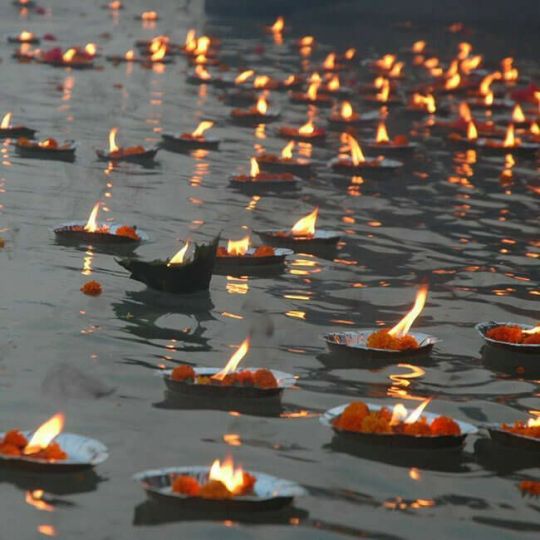
107 notes
·
View notes
Text
Theory on that Crimson Jimson-Weed;
So I was re-watching "To Catch a Leaf" like any good Sandy-fan when I recognised the name of the flower (Crimson Jimsonweed/Scarlet Mandala flower) being something I encountered in my horticulture/pharma studies;

You see, Jimsonweed is another name for Datura - a super-toxic nightshade flower known for it's psychoactive effects that was occasionally used in traditional Chinese medicine. A few seeds or leaves is enough to send someone into days-long potentially fatal delirium. Monk in India particularly used it to induce horror/madness in order to have a better understanding of the world.
My first thought was; "Why tf would Sandy reccomend a flower that's like a million acid trips in one?" and second "Why did LBD need it?"
According to Sandy the Crimson Jimsonweed can "influence mortality itself" - something that would be very useful if your opponent is someone who's pretty protective of their immortality. NO wonder why LBD was pissed. Huntsman "only" taking a single petal could have saved the gang's lives in the long run.
And I thought: "Cool!"
And then I was researching an au idea/theory @dorothygale123 brought up about "Shennong/The Flame Emperor/Divine Peasant" having connections to the Demon Bull King and Red Son; only to read how he (a primordial god of fire and medicine) died;


You see, after he retired/lost the godly throne, Shennong decided to put his brain and super-durable/transparent stomach to use and self-experiment on himself and document the results. He apparently got poisoned quite a lot in his research (he also discovered many ways to get high) to classify all plant life.
Ultimately Shennong died after eating a "small yellow flower" and being unable to find an antidote or "clean out his instestine" in time. Kind of a sad but expected end to the chinese mythos version of the first farmer-scientist. A rule of medicine is that anything that can heal can also kill at a certain dosage.
But the flower that killed him is up for debate. The book I have suggests it to be "Intestine-Breaking/Heartbreak Grass"(Gelsemium sempervirens). This Oxford paper suggests Tansy, an old treatment for worms. But a common theme is that the "flower of a weed" was the cause.



After my research into Jimsonweed and it's connections to mortality in Buddhism I must suggest a hidden culpurit;
This could be my mild red-colourblindness acting up; but The flower we see throughout the "To Catch a Leaf" is gotdamn yellow.

The flower that can "influence mortality itself" would be the perfect candiate for what killed the legendary Divine Peasant.
Makes sense why Sandy decided to instead brew a very small part of it into tea for MK. He likely read Shennong's research and realised that this super-rare variant of Jimsonweed *was* an amazing tonic... in the right dosage of course. Hence why Sandy didn't feed MK the whole flower.
#shennong#lmk shennong#the flame emperor#the divine farmer#lmk character ideas#lmk sandy#lmk to catch a leaf#lmk huntsman#lmk#lego monkie kid#lmk theories#chinese mythology#lmk aus#horticulture is fun
66 notes
·
View notes
Text
tuesday again 8/8/2023
theoretically seeing two apartments this afternoon so i am taking the date as good luck
listening
the asteroids galaxy tour's the sun ain’t shinin no more. this was apparently a very famous iPod commercial song? wasn't paying attention to general popular culture when the original iPods were coming out. i would attempt to classify this as somewhere between the doors and smash mouth. spotify.
bitches by tove lo (feat charli xcx, icona pop, elliphant, ALMA). is this a good song? eh. is it fun to scream-sing while navigating through packs of lifted pickups whose hoods are higher than the roof of my moderately-sized hatchback? yes. spotify
how'd i find these? really leaning hard on spotify autogenerated dance playlists these days.
-
reading
normal pair of books to read at the same time
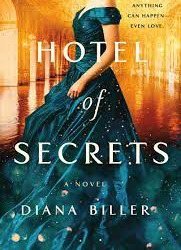

diana biller's hotel of secrets was an odd one. you CANNOT take away from this section "oh tumblr user girlfriendsofthegalaxy hates consent" okay? i don't piss on the poor either. i had to really think about if i thought the sex scenes were jarringly modern and concluded no, they simply challenged my preconceptions of what a single mid-thirties woman in late 1800s vienna might get up to in a time when the best available methods of birth control were french letters. however, the lengthy discussion around consent and boundaries read as somewhat performative and out of place? or like a slightly different tone? than the rest of the actual sex scenes.
in many ways the romance was the b-plot to the hotel's inner workings and the international intrigue, which was fun. i enjoyed the a-plot enough to put a hold on biller's next romance, about a young american window in gilded age nyc. we'll see how that all shakes out!
i did not enjoy and did not finish chris miller's hefty pop history book on the history of microchip production and manufacture. got about a third of the way through. i think i most disliked his approach-- the technical style is very polished, one sentence flows into the next quite well, although we have very different opinions about the meaning of "intuitive" -- but we sit in very different seats watching the american political thunderdome. the way he presents his ideas is a bit jarring, bc it is an almost full-throated and uncritical endorsement of america's cold war diplomatic policies. i think many people would agree with me when i say those policies were not very good.
both of these have been on my holds list for months and i could not tell you the inciting incidents that made me place a hold.
-
watching
in my best friend's endless search for Things to Have on in the Background That Are Semi Child Friendly (or THBTASCF), i have viewed National Treasure (2004, dir. Turteltaub), Rush Hour (1998, dir. Ratner) and Rush Hour 2 (2001, dir. Ratner).

i cannot say i truly enjoyed any of these choices or that they have aged particularly well. national treasure has such an ominous looming of the whedonesque Well That Happened!!! that continues to infect movies.
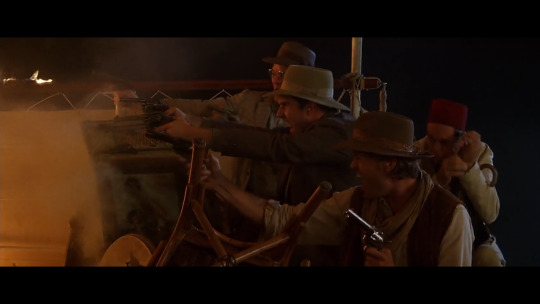
also rewatched The Mummy (1999, dir. Sommers) bc i wanted a screenshot of the subtitles [YEEHAWING, GUNSHOTS] which is my Texas Adventure(TM) tag, but the subtitles on my pirate movie platform of choice are not that sophisticated. you'll simply have to take my word for it bc my dvd box set is still in storage.
-
playing
mainlining g/enshin impact. did not realize a whole nother goddamn country is being released next week. their every-six-weeks major content update schedule is batshit insane and i do not want to really think about the level of crunch happening over there.
the regions we have so far are legally-not-switzerland, not-china, not-japan, not-india, and we are going to not-france next. it has a real jules verne/twenty thousand leagues under the sea/steampunk vibe about it. look at this whimsical little deep-sea diver boy!

i have not enjoyed this past region (sumeru, legally-not-india) as much as the others. this may be due to the hiccup of seasonal depression i am experiencing. it may be bc this is the most Contiguous Landmass segment of the map and it's less segmented into individual regions than the other countries. it may be bc i have not spent quite as much time running around here as i have liyue (legally-not-china) which does feel genuinely comforting to run around. it may be bc the last time i played this game i still worked in the games industry and i still have residual brain weirdness about playing games.
i do appreciate their dedication to Big Fuckoff Trees tho.

-
making
fallow weeks. things are simply not percolating in time for yeehawgust, due to the agonies, and that's fine, i'm telling myself through gritted teeth.
22 notes
·
View notes
Note
Do you have any recommendations for romance novels with women who are sexually dominate?
Lol idk about sexually dominant per se but here's some romance novels that have that vibe.
Brazen and the Beast by Sarah MacLean: at one point she ties him to the mast of the ship, enough said. I'm personally a huge Day of the Duchess fan as well, and one aspect of that book that I really loved is that it was about giving Seraphina agency that she lacked. Also, Heartbreaker is also a really great book in terms of sexually dominant female leads because for one thing, Adelaide isn't a blushing virgin so there's no easing in period and it's hotter for that.
Devil in Winter by Lisa Kleypas: So like, Sebastian St. Vincent is recovering from an injury and making himself be celibate ("I'm Sebastian, Lord St. Vincent. I can't be celibate. Everyone knows that") so that his wife will fuck him and said wife basically climbs on top of him while he's comatose (it's all consensual obviously) and rides him. It's very hot but also hilarious.
A Rogue's Rules for Seduction by Eva Leigh: a truly excellent second-chance romance, and well, let's just say that Willa gets to ... take charge so to speak, in a way that's very rare for mainstream romance that's not ~erotica~
Thief of Shadows (Maiden Lane #4) by Elizabeth Hoyt: There's a blowjob scene in this one that made me gasp out loud (and then start crying) and I'd definitely classify that as dominant. Plus, the hero in that one is a virgin! Also, Duke of Midnight (Maiden Lane #6) has a scene in a chair that's ... intense and I don't know if I'd classify it as dominant but that particular one is one of my favorites because it's a cross class romance that doesn't feel remotely inequal, which is super rare when the man's the wealthier party
The Duke Gets Even by Joanna Shupe: This is probably my favorite Shupe novel (along with The Prince of Broadway), and something I loved is that Nellie, who's basically a lady rake for lack of better term, gives as good as she gets. There are multiple instances where she CLAWS at Lockwood to the extent of leaving marks, and it's just so refreshing to read.
For the Duke’s Eyes Only by Lenora Bell: I haven't read this one in a while but from what I can remember, aside from the fact it's like, basically a gender-swapped Indiana Jones (Lady India Rochester) and Marian Ravenwood (The Duke of Ravenwood) with a very dramatic and headstrong heroine, there's a rare 69 scene, which almost never happens in historical romance.
Her Night with the Duke by Diana Quincy: A widow heroine who attempts (and fails) to have a one night stand lol. Also, I loved that this book really hits on the fact that just because you end up together doesn't mean that all your flaws as an individual just go away. At one point, the hero stalks away from the heroine during an argument because he's avoidant and instead of just letting him have his time, she stalks out after him to tell him he's being stupid (and they end up having sex against a tree).
A Rogue of One’s Own by Evie Dunmore: the best of Dunmore’s books, a childhood friends-enemies-lovers and I cried a LOT. Also, Oscar Wilde shows up!
That should get you started!
15 notes
·
View notes
Text


























National Herb Day
It is National Herb Day on May 4! It is usually celebrated annually on the first Saturday of May. The HerbDay Coalition, an organization of five non-profit groups, started National Herb Day to raise awareness about the useful properties and importance of herbs in daily life. They also work towards encouraging people to learn more about the herbs and provide a better understanding of the extensive uses of herbs in daily life. Herbs are extensively used in food, medicines, and cosmetics. They also served as the first medicines ever used by humans to cure various ailments.
History of National Herb Day
Botanically, herbs are classified as the green parts of a plant used in food or medicine. Herbs are as old as human civilizations and have been used for cooking and medicine since time immemorial. There is well-preserved archaeological evidence pointing to the use of herbs 60,000 years ago. Neanderthals, ancestors of modern Homo sapiens, started using herbs for healing. In a way, we can say that herbs predate even that of recorded history and form the origin of much of modern medicine. Archeologists have discovered traces of pollen and other plant materials near burials, indicating the use of herbs.
There is hardly any civilization that didn’t take advantage of the use of herbs. The Sumerians, Egyptians, Indians, and Chinese all used herbs independently of one another. They created clay tablets that date back 5,000 years and listed hundreds of medicinal plants on them. In Egypt, texts like Papyrus Ebers describe ailments, treatments, and around 850 medicinal plants. The Indian medicinal school of Ayurveda, which uses natural remedies and herbal medicine to cure health conditions, is still prevalent in this modern age. Ayurvedic medicine has used many herbs dating back to 4000 B.C.
The study and use of herbs thrived in the Middle Ages when most cultures attributed spiritual qualities to herbs. A prominent example is the holy status of basil leaves in India. There is also a resurgence in the use of herbs in the last 40 years due to the impact of chemical drugs and the investment in pharmaceutical research and development. To address the growing popularity of herbs and to spread their importance, the HerbDay Coalition started National Herb Day.
National Herb Day timeline
6,000 Years Ago
The Rise of Ayurveda
The “Rig Veda” and the “Atharva Veda,” the Vedic scriptures of Hinduism, mention the prevalence of medicinal plants and Ayurveda.
5,000 Years Ago
Sumerian Texts on Herbs
Sumerians write about hundreds of medicinal herbs on clay tablets.
1526 A.D.
The First English Herbal
Peter Treveris prints “Grete Herball,” the first English herbal.
1600 — 1700
The Era of Bubonic Plague
The popularity of herbal medicines declines because of their ineffectiveness against the Bubonic Plague.
National Herb Day FAQs
How many herbs are there in the United States?
There are approximately 75 to 100 herbs listed in the National Library of Medicine
What is the most popular herb in the world?
Cumin is generally considered the most popular herb in the world.
Is an herb a vegetable?
Herbs are a subset of vegetables, which are generally composed of flavorful leaves of plants such as cilantro and basil.
National Herb Day Activities
Buy herbal products: Herbal products are rich in medicinal properties and nutrient values. Purchase herbal products for your daily use.
Invite friends for an herbal-themed party: Invite friends for an herbal-themed party. Create food and decorations in the shape of various herbs available in your locality.
Create an herbal garden: Create an herbal garden in your backyard. Try herbs that are already available in your locality before expanding your horizons over time.
5 Facts About Herbs That You Should Know
Stronger flavor for dried herbs: Both dried and fresh herbs can be used, but dried herbs have a stronger flavor.
Herbalists and botanists: In the middle ages, botanists were known as herbalists.
Herbal: The book of plants: A book containing the names, legends, stories, and descriptions of plants is called a ‘herbal.’
Herbal medicine users: 80% of people worldwide use herbal medicines.
Herbal medicines in Germany: Around 600 to 700 plant-based medicines are available in Germany.
Why We Love National Herb Day
Low side effects: Herbal medicines have fewer side effects compared to modern medications. It may be slow compared to modern medicine, but certain herbal medicines are effective against many lifestyle diseases.
Good for health: Herbs are good for your health. They are rich in nutrients and have medicinal value.
A second option: Herbal medicines are a second option for various lifestyle diseases. Major diseases like diabetes can be controlled with herbal remedies.
Source
#National Herb Day#4 May 2024#NationalHerbDay#first Saturday in May#salmon with potato salad#bratwurst#cabbage#Steakpfanne#Sweden#Germany#food#restaurant#original photography#Truffle Fries with parmesan reggiano#Garlic Fries#USA#roasted potatoes#mushroom#Madeleine#loaded baked potato#travel#vacation#Filet Port#scallops#Cataplana de marisco
2 notes
·
View notes
Text
2023 Reading Log, pt 2

006. Nightmare Fuel: The Science of Horror Films by Nina Nesseth. This book is about how and why people feel fear, incorporating ideas from neuroscience and psychology, it talks about what happens in the brain when someone is afraid, why a horror movie might be scarier when you’re going to bed at night then when you’re actually watching it, and a very good discussion of the controversies about whether exposure to media violence actually desensitizes people or makes them more likely to commit violence themselves. The authorial voice is fun, like a friend who has learned all this cool stuff and wants you to know about it. And the author is a married lesbian and brings her wife up very casually (her wife is terrified of ET, for example), which is always a plus in my book.

007. Heist by Pete Stegemeyer. This is another “podcast adapted into a book” that I didn’t know was based on a podcast. I Can Steal That!, specifically. The heists are classified into loose categories—ones involving unusual transportation, bank jobs, art theft, digital crimes, unusual items stolen. There’s some stories in here I knew; the James-Younger gang is mentioned twice, and the theft of the Mona Lisa is one of the art pieces mentioned. But a lot of it is new to me. The stories are told in a breezy way, but sometimes a little out of order: the organization of the book makes for some odd choices and reveals, maybe as a consequence of its origins in an audio medium. There are illustrations throughout by Rebecca Pry, in a style that is pretty distinctive. Objects are detailed and realistic, but people are cartoony.

008. Folk Tales of the Maldives by Xavier Romero-Frias. The Maldives are a country that I knew very little about before reading this. They’re an island nation in the Indian Ocean, with a majority Muslim population and cultural ties to Arabia and India. There’s a lengthy prologue about Maldivian culture, which bemoans that their unique traditions are being altered or erased by cultural assimilation. There are eighty stories in the book, ranging from overtly supernatural tales of magic and monsters, to animal fables of the kind found almost universally, to folk history of fairly recent events. Like WWII and the first tourist to bring a scuba tank to the island, level of recent. The author also illustrates some of the stories in an amateurish but charming pencil style.

009. The Lion Boy and Other Medical Curiosities by Jan Bondeson. I am torn on this book. I read it all the way through, but found it a somewhat unpleasant experience. The content is good: it alternates between biographies and possible diagnoses for various “human oddities” from the 18th through early 20th centuries and more general medical weirdness from that time. Like doctors debating how long a severed head retained consciousness and whether or not someone’ hair could literally go white from fear. A lot of the material is gleaned from primary sources—newspaper accounts and medical journal articles. What’s bad about the book is the authorial voice. He’s remarkably judgmental about people’s physical appearance (human oddity or not), very fatphobic and even manages to slip in a racist joke! He comes across as a huge asshole, is what I’m saying. I wish this book had been written by someone more humane and respectful, like a Ricky Jay type.
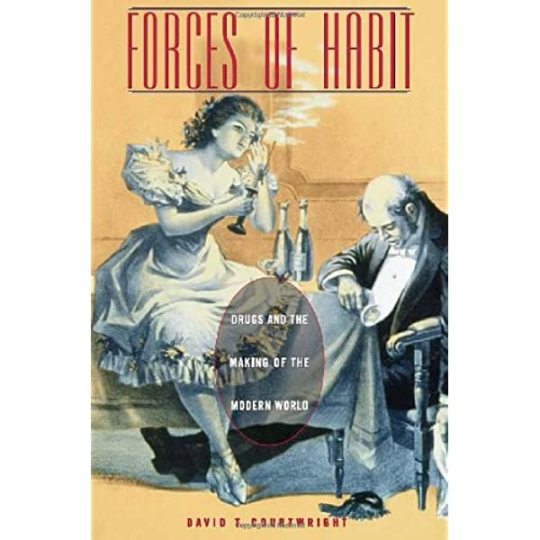
010. Forces of Habit: Drugs and the Making of the Modern World by David T. Courtwright. This book is about the history of drug use, the development of global capitalism, and how tightly the two are linked. It first discusses what the author deems are the most important drugs: caffeine, alcohol, tobacco, opiates, cocaine, cannabis. It then talks about the role that doctors and medicine play in promoting drugs, debates why some plant products became major international drugs and others didn’t, and discusses why total prohibition is a fool’s errand. The book was written in 2000, but still feels fresh and relevant—concepts like the ladder of technological development of drugs from raw plant product to fully synthetic analogues is relevant to the rise of vaping, and the section about how amphetamines were first promoted, then demonized by doctors could be an account of the opiod epidemic. Highly recommended.
#reading log#drugs are like that#drugs#medical history#medical oddities#true crime#horror movies#neuroscience#folklore#the maldives
15 notes
·
View notes
Text
Reach out to a wider audience with The Times of India Classified Ads!
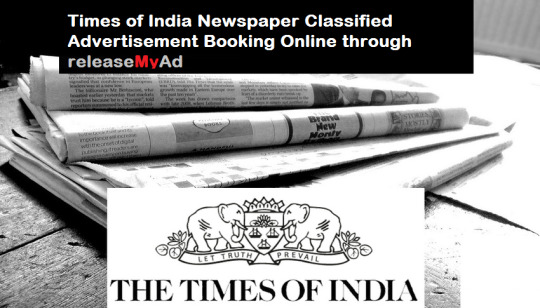
#times of india classified ads#times of india classified ad booking#book times classified ads online#times classifieds#ad in times classified ad booking#book times classifed ad online#times advertisement
0 notes
Text
Get the lowest Times of India ad rates for all your advertising needs!

#times classified ads#times classified ad booking#book times of india classified ad online#online classified ad booking in times#times advertisement#times classified classified ad booking#book times classified advertisement online#times of india advertisement rate card
0 notes
Text
20k Leagues under the sea, Jules Verne
PART ONE
CHAPTER I
A SHIFTING REEF
The year 1866 was signalised by a remarkable incident, a mysterious and puzzling phenomenon, which doubtless no one has yet forgotten. Not to mention rumours which agitated the maritime population and excited the public mind, even in the interior of continents, seafaring men were particularly excited. Merchants, common sailors, captains of vessels, skippers, both of Europe and America, naval officers of all countries, and the Governments of several states on the two continents, were deeply interested in the matter.
For some time past, vessels had been met by “an enormous thing,” a long object, spindle-shaped, occasionally phosphorescent, and infinitely larger and more rapid in its movements than a whale.
The facts relating to this apparition (entered in various log-books) agreed in most respects as to the shape of the object or creature in question, the untiring rapidity of its movements, its surprising power of locomotion, and the peculiar life with which it seemed endowed. If it was a cetacean, it surpassed in size all those hitherto classified in science. Taking into consideration the mean of observations made at divers times,—rejecting the timid estimate of those who assigned to this object a length of two hundred feet, equally with the exaggerated opinions which set it down as a mile in width and three in length,—we might fairly conclude that this mysterious being surpassed greatly all dimensions admitted by the ichthyologists of the day, if it existed at all. And that it did exist was an undeniable fact; and, with that tendency which disposes the human mind in favour of the marvellous, we can understand the excitement produced in the entire world by this supernatural apparition. As to classing it in the list of fables, the idea was out of the question.
On the 20th of July, 1866, the steamer Governor Higginson, of the Calcutta and Burnach Steam Navigation Company, had met this moving mass five miles off the east coast of Australia. Captain Baker thought at first that he was in the presence of an unknown sandbank; he even prepared to determine its exact position, when two columns of water, projected by the inexplicable object, shot with a hissing noise a hundred and fifty feet up into the air. Now, unless the sandbank had been submitted to the intermittent eruption of a geyser, the Governor Higginson had to do neither more nor less than with an aquatic mammal, unknown till then, which threw up from its blow-holes columns of water mixed with air and vapour.
Similar facts were observed on the 23rd of July in the same year, in the Pacific Ocean, by the Columbus, of the West India and Pacific Steam Navigation Company. But this extraordinary cetaceous creature could transport itself from one place to another with surprising velocity; as, in an interval of three days, the Governor Higginson and the Columbus had observed it at two different points of the chart, separated by a distance of more than seven hundred nautical leagues.
Fifteen days later, two thousand miles farther off, the Helvetia, of the Compagnie-Nationale, and the Shannon, of the Royal Mail Steamship Company, sailing to windward in that portion of the Atlantic lying between the United States and Europe, respectively signalled the monster to each other in 42° 15′ N. lat. and 60° 35′ W. long. In these simultaneous observations they thought themselves justified in estimating the minimum length of the mammal at more than three hundred and fifty feet, as the Shannon and Helvetia were of smaller dimensions than it, though they measured three hundred feet over all.
Now the largest whales, those which frequent those parts of the sea round the Aleutian, Kulammak, and Umgullich islands, have never exceeded the length of sixty yards, if they attain that.
These reports arriving one after the other, with fresh observations made on board the transatlantic ship Pereire, a collision which occurred between the Etna of the Inman line and the monster, a procès verbal directed by the officers of the French frigate Normandie, a very accurate survey made by the staff of Commodore Fitz-James on board the Lord Clyde, greatly influenced public opinion. Light-thinking people jested upon the phenomenon, but grave practical countries, such as England, America, and Germany, treated the matter more seriously.
In every place of great resort the monster was the fashion. They sang of it in the cafés, ridiculed it in the papers, and represented it on the stage. All kinds of stories were circulated regarding it. There appeared in the papers caricatures of every gigantic and imaginary creature, from the white whale, the terrible “Moby Dick” of hyperborean regions, to the immense kraken whose tentacles could entangle a ship of five hundred tons, and hurry it into the abyss of the ocean. The legends of ancient times were even resuscitated, and the opinions of Aristotle and Pliny revived, who admitted the existence of these monsters, as well as the Norwegian tales of Bishop Pontoppidan, the accounts of Paul Heggede, and, last of all, the reports of Mr. Harrington (whose good faith no one could suspect), who affirmed that, being on board the Castillan, in 1857, he had seen this enormous serpent, which had never until that time frequented any other seas but those of the ancient “Constitutionnel.”
Then burst forth the interminable controversy between the credulous and the incredulous in the societies of savants and the scientific journals. “The question of the monster” inflamed all minds. Editors of scientific journals, quarrelling with believers in the supernatural, spilled seas of ink during this memorable campaign, some even drawing blood; for, from the sea-serpent they came to direct personalities.
For six months war was waged with various fortune in the leading articles of the Geographical Institution of Brazil, the Royal Academy of Science of Berlin, the British Association, the Smithsonian Institution of Washington, in the discussions of the “Indian Archipelago,” of the Cosmos of the Abbé Moigno, in the Mittheilungen of Petermann, in the scientific chronicles of the great journals of France and other countries. The cheaper journals replied keenly and with inexhaustible zest. These satirical writers parodied a remark of Linnæus, quoted by the adversaries of the monster, maintaining “that nature did not make fools,” and adjured their contemporaries not to give the lie to nature, by admitting the existence of krakens, sea-serpents, “Moby Dicks,” and other lucubrations of delirious sailors. At length an article in a well-known satirical journal by a favourite contributor, the chief of the staff, settled the monster, like Hippolytus, giving it the death-blow amidst an universal burst of laughter. Wit had conquered science.
During the first months of the year 1867 the question seemed buried, never to revive, when new facts were brought before the public. It was then no longer a scientific problem to be solved, but a real danger seriously to be avoided. The question took quite another shape. The monster became a small island, a rock, a reef, but a reef of indefinite and shifting proportions.
On the 5th of March, 1867, the Moravian, of the Montreal Ocean Company, finding herself during the night in 27° 30′ lat. and 72° 15′ long., struck on her starboard quarter a rock, marked in no chart for that part of the sea. Under the combined efforts of the wind and its four hundred horse-power, it was going at the rate of thirteen knots. Had it not been for the superior strength of the hull of the Moravian, she would have been broken by the shock and gone down with the 237 passengers she was bringing home from Canada.
The accident happened about five o’clock in the morning, as the day was breaking. The officers of the quarter-deck hurried to the after-part of the vessel. They examined the sea with the most scrupulous attention. They saw nothing but a strong eddy about three cables’ length distant, as if the surface had been violently agitated. The bearings of the place were taken exactly, and the Moravian continued its route without apparent damage. Had it struck on a submerged rock, or on an enormous wreck? they could not tell; but on examination of the ship’s bottom when undergoing repairs, it was found that part of her keel was broken.
This fact, so grave in itself, might perhaps have been forgotten like many others if, three weeks after, it had not been re-enacted under similar circumstances. But, thanks to the nationality of the victim of the shock, thanks to the reputation of the company to which the vessel belonged, the circumstance became extensively circulated.
The 13th of April, 1867, the sea being beautiful, the breeze favourable, the Scotia, of the Cunard Company’s line, found herself in 15° 12′ long. and 45° 37′ lat. She was going at the speed of thirteen knots and a half.
At seventeen minutes past four in the afternoon, whilst the passengers were assembled at lunch in the great saloon, a slight shock was felt on the hull of the Scotia, on her quarter, a little aft of the port-paddle.
The Scotia had not struck, but she had been struck, and seemingly by something rather sharp and penetrating than blunt. The shock had been so slight that no one had been alarmed, had it not been for the shouts of the carpenter’s watch, who rushed on to the bridge, exclaiming, “We are sinking! we are sinking!” At first the passengers were much frightened, but Captain Anderson hastened to reassure them. The danger could not be imminent. The Scotia, divided into seven compartments by strong partitions, could brave with impunity any leak. Captain Anderson went down immediately into the hold. He found that the sea was pouring into the fifth compartment; and the rapidity of the influx proved that the force of the water was considerable. Fortunately this compartment did not hold the boilers, or the fires would have been immediately extinguished. Captain Anderson ordered the engines to be stopped at once, and one of the men went down to ascertain the extent of the injury. Some minutes afterwards they discovered the existence of a large hole, of two yards in diameter, in the ship’s bottom. Such a leak could not be stopped; and the Scotia, her paddles half submerged, was obliged to continue her course. She was then three hundred miles from Cape Clear, and after three days’ delay, which caused great uneasiness in Liverpool, she entered the basin of the company.
The engineers visited the Scotia, which was put in dry dock. They could scarcely believe it possible; at two yards and a half below water-mark was a regular rent, in the form of an isosceles triangle. The broken place in the iron plates was so perfectly defined that it could not have been more neatly done by a punch. It was clear, then, that the instrument producing the perforation was not of a common stamp; and after having been driven with prodigious strength, and piercing an iron plate 1-3/8 inches thick, had withdrawn itself by a retrograde motion truly inexplicable.
Such was the last fact, which resulted in exciting once more the torrent of public opinion. From this moment all unlucky casualties which could not be otherwise accounted for were put down to the monster. Upon this imaginary creature rested the responsibility of all these shipwrecks, which unfortunately were considerable; for of three thousand ships whose loss was annually recorded at Lloyd’s, the number of sailing and steam ships supposed to be totally lost, from the absence of all news, amounted to not less than two hundred!
Now, it was the “monster” who, justly or unjustly, was accused of their disappearance, and, thanks to it, communication between the different continents became more and more dangerous. The public demanded peremptorily that the seas should at any price be relieved from this formidable cetacean.
CHAPTER II
PRO AND CON
At the period when these events took place, I had just returned from a scientific research in the disagreeable territory of Nebraska, in the United States. In virtue of my office as Assistant Professor in the Museum of Natural History in Paris, the French Government had attached me to that expedition. After six months in Nebraska, I arrived in New York towards the end of March, laden with a precious collection. My departure for France was fixed for the first days in May. Meanwhile, I was occupying myself in classifying my mineralogical, botanical, and zoological riches, when the accident happened to the Scotia.
I was perfectly up in the subject which was the question of the day. How could I be otherwise? I had read and re-read all the American and European papers without being any nearer a conclusion. This mystery puzzled me. Under the impossibility of forming an opinion, I jumped from one extreme to the other. That there really was something could not be doubted, and the incredulous were invited to put their finger on the wound of the Scotia.
On my arrival at New York the question was at its height. The hypothesis of the floating island, and the unapproachable sandbank, supported by minds little competent to form a judgment, was abandoned. And, indeed, unless this shoal had a machine in its stomach, how could it change its position with such astonishing rapidity?
From the same cause, the idea of a floating hull of an enormous wreck was given up.
There remained then only two possible solutions of the question, which created two distinct parties: on one side, those who were for a monster of colossal strength; on the other, those who were for a submarine vessel of enormous motive power.
But this last hypothesis, plausible as it was, could not stand against inquiries made in both worlds. That a private gentleman should have such a machine at his command was not likely. Where, when, and how was it built? and how could its construction have been kept secret? Certainly a Government might possess such a destructive machine. And in these disastrous times, when the ingenuity of man has multiplied the power of weapons of war, it was possible that, without the knowledge of others, a state might try to work such a formidable engine. After the chassepots came the torpedoes, after the torpedoes the submarine rams, then—the reaction. At least, I hope so.
But the hypothesis of a war machine fell before the declaration of Governments. As public interest was in question, and transatlantic communications suffered, their veracity could not be doubted. But, how admit that the construction of this submarine boat had escaped the public eye? For a private gentleman to keep the secret under such circumstances would be very difficult, and for a state whose every act is persistently watched by powerful rivals, certainly impossible.
After inquiries made in England, France, Russia, Prussia, Spain, Italy, and America, even in Turkey, the hypothesis of a submarine monitor was definitely rejected.
Upon my arrival in New York several persons did me the honour of consulting me on the phenomenon in question. I had published in France a work in quarto, in two volumes, entitled “Mysteries of the Great Submarine Grounds.” This book, highly approved of in the learned world, gained for me a special reputation in this rather obscure branch of Natural History. My advice was asked. As long as I could deny the reality of the fact, I confined myself to a decided negative. But soon, finding myself driven into a corner, I was obliged to explain myself categorically. And even “the Honourable Pierre Aronnax, Professor in the Museum of Paris,” was called upon by the New York Herald to express a definite opinion of some sort. I did something. I spoke, for want of power to hold my tongue. I discussed the question in all its forms, politically and scientifically; and I give here an extract from a carefully-studied article which I published in the number of the 30th of April. It ran as follows:—
“After examining one by one the different hypotheses, rejecting all other suggestions, it becomes necessary to admit the existence of a marine animal of enormous power.
“The great depths of the ocean are entirely unknown to us. Soundings cannot reach them. What passes in those remote depths—what beings live, or can live, twelve or fifteen miles beneath the surface of the waters—what is the organisation of these animals, we can scarcely conjecture. However, the solution of the problem submitted to me may modify the form of the dilemma. Either we do know all the varieties of beings which people our planet, or we do not. If we do not know them all—if Nature has still secrets in ichthyology for us, nothing is more conformable to reason than to admit the existence of fishes, or cetaceans of other kinds, or even of new species, of an organisation formed to inhabit the strata inaccessible to soundings, and which an accident of some sort, either fatastical or capricious, has brought at long intervals to the upper level of the ocean.
“If, on the contrary, we do know all living kinds, we must necessarily seek for the animal in question amongst those marine beings already classed; and, in that case, I should be disposed to admit the existence of a gigantic narwhal.
“The common narwhal, or unicorn of the sea, often attains a length of sixty feet. Increase its size fivefold or tenfold, give it strength proportionate to its size, lengthen its destructive weapons, and you obtain the animal required. It will have the proportions determined by the officers of the Shannon, the instrument required by the perforation of the Scotia, and the power necessary to pierce the hull of the steamer.
“Indeed, the narwhal is armed with a sort of ivory sword, a halberd, according to the expression of certain naturalists. The principal tusk has the hardness of steel. Some of these tusks have been found buried in the bodies of whales, which the unicorn always attacks with success. Others have been drawn out, not without trouble, from the bottoms of ships, which they had pierced through and through, as a gimlet pierces a barrel. The Museum of the Faculty of Medicine of Paris possesses one of these defensive weapons, two yards and a quarter in length, and fifteen inches in diameter at the base.
“Very well! suppose this weapon to be six times stronger and the animal ten times more powerful; launch it at the rate of twenty miles an hour, and you obtain a shock capable of producing the catastrophe required. Until further information, therefore, I shall maintain it to be a sea-unicorn of colossal dimensions, armed not with a halberd, but with a real spur, as the armoured frigates, or the ‘rams’ of war, whose massiveness and motive power it would possess at the same time. Thus may this puzzling phenomenon be explained, unless there be something over and above all that one has ever conjectured, seen, perceived, or experienced; which is just within the bounds of possibility.”
These last words were cowardly on my part; but, up to a certain point, I wished to shelter my dignity as Professor, and not give too much cause for laughter to the Americans, who laugh well when they do laugh.
I reserved for myself a way of escape. In effect, however, I admitted the existence of the “monster.” My article was warmly discussed, which procured it a high reputation. It rallied round it a certain number of partisans. The solution it proposed gave, at least, full liberty to the imagination. The human mind delights in grand conceptions of supernatural beings. And the sea is precisely their best vehicle, the only medium through which these giants (against which terrestrial animals, such as elephants or rhinoceroses, are as nothing) can be produced or developed.
The industrial and commercial papers treated the question chiefly from this point of view. The Shipping and Mercantile Gazette, the Lloyd’s List, the Packet-Boat, and the Maritime and Colonial Review, all papers devoted to insurance companies which threatened to raise their rates of premium, were unanimous on this point. Public opinion had been pronounced. The United States were the first in the field; and in New York they made preparations for an expedition destined to pursue this narwhal. A frigate of great speed, the Abraham Lincoln, was put in commission as soon as possible. The arsenals were opened to Commander Farragut, who hastened the arming of his frigate; but, as it always happens, the moment it was decided to pursue the monster, the monster did not appear. For two months no one heard it spoken of. No ship met with it. It seemed as if this unicorn knew of the plots weaving around it. It had been so much talked of, even through the Atlantic cable, that jesters pretended that this slender fly had stopped a telegram on its passage and was making the most of it.
So when the frigate had been armed for a long campaign, and provided with formidable fishing apparatus, no one could tell what course to pursue. Impatience grew apace, when, on the 2nd of July, they learned that a steamer of the line of San Francisco, from California to Shanghai, had seen the animal three weeks before in the North Pacific Ocean. The excitement caused by this news was extreme. The ship was revictualled and well stocked with coal.
Three hours before the Abraham Lincoln left Brooklyn pier, I received a letter worded as follows:—
“To M. ARONNAX, Professor in the Museum of Paris, Fifth Avenue Hotel, New York.
“SIR,—If you will consent to join the Abraham Lincoln in this expedition, the Government of the United States will with pleasure see France represented in the enterprise. Commander Farragut has a cabin at your disposal.
“Very cordially yours,
“J.B. HOBSON,
“Secretary of Marine"
NEXT >>
5 notes
·
View notes
Text
There's a lot to unpack here so I'm going to skip any unnecessary part. A day has passed, I have been through more books than I own and I had to limit the amount of information to note since my head is overflowing. Here's a few pages on alchemy practised in different parts of the world:

Transcript of the first page:
Alchemist tried to split anything into very very mall pieces. There was even the attempt of a periodic system that puts chemical elements in order. Though they used so called "Decknamen", secret codes for substances only alchemists understood. There are a few noble metals: gold (associated with the sun) and silver (with the moon). The base metals are quicksilver and mercury (associated with mercury), copper (with venus), iron (with mars) and tin (associated with jupiter).
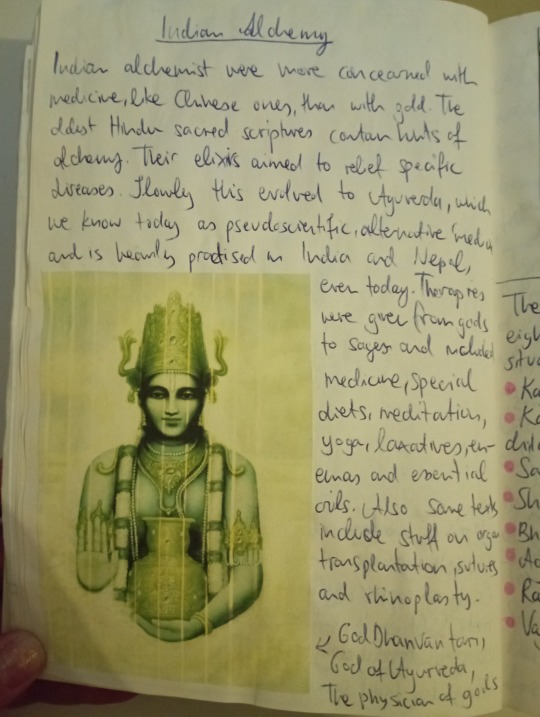
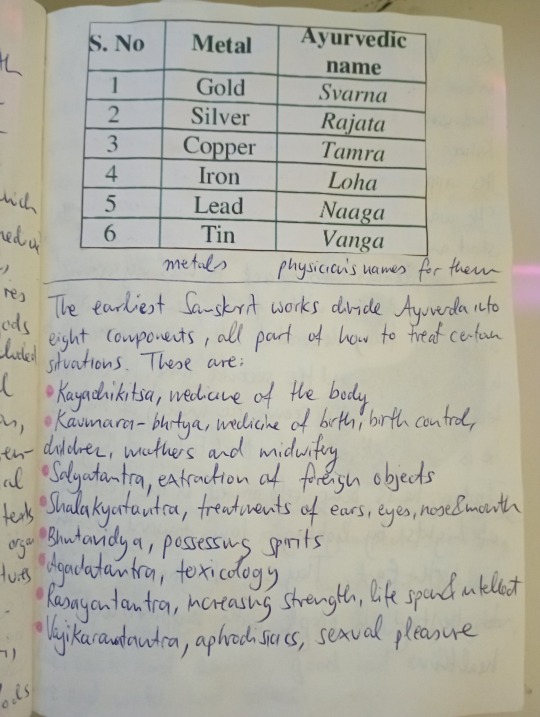

Transcript of the second and third and fourth page:
Indian alchemists didn't care much about gold but rather health. Even the oldest sacred Hindu texts contain alchemy and their elixirs were aimed to relief specific pains and diseases. Through this Ayurverda came into existence which is used today in India and Nepal and has no scientific evidence to support its use. It is said that gods have given mortals the recipies, including special diets, forms of meditation and essential oil mixtures. Even organ transplantation and rhinoplasty are mentioned.
Lord Vishnu came to Earth and taught medicine as Dhanvanthari. His first appearance is in the Ksheer Sagar, the cosmic ocean of milk: "He was strongly built(...), his eyes were reddish and his complexion was black. (...) his entire body was decorated with various ornaments." The second time on Earth he gave humans Ayurveda and is referred to as "father of surgery". He is celebrated today in the Festival of Lights and people ask for happiness and health for all people.

Transcript of the fifth page:
Chinese alchemists were interested in medicine and physical immortaloty, and invented an "elixir of life", also called "drinkable gold" and accidentally invented gun powder. A lot of influence came from Taoism, the only religion and philosophy of China, which relies on the concept of dualism. Opposite forces belong together, even if they initially clash, like winter and summer, good and evil and water and fire.

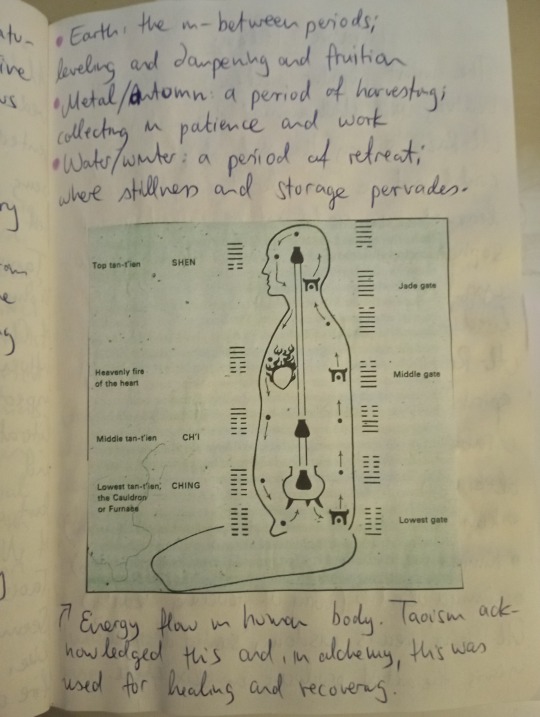
Transcript of the sixth nd seventh page:
Another part from the "School of Naturalists", the belief in Taoism, is the concept of the "Five Phases". The generative cycle is the arrows clockwise on the outside, the destructive cycle is the inside arrows. The phases last 73 days:
wood/spring: period of growth; generates abundant wood and virtality
fire/summer: period of swelling; brimming with fire and energy
earth, the in-between period: leveling and dampening and fruition
metal/autumn: a period of harvesting; collecting patience and work
water/winter: a period of retreat; where stillness and storage pervades.
The flow of energy in human bodies was used as a base for healing and recovering.
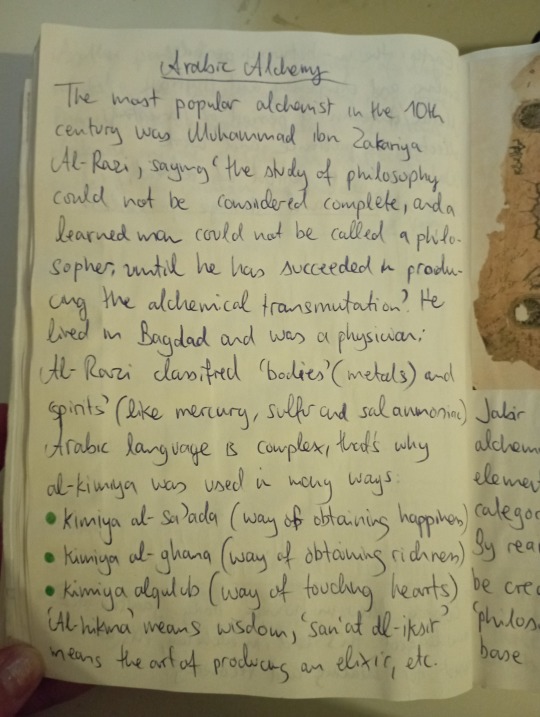
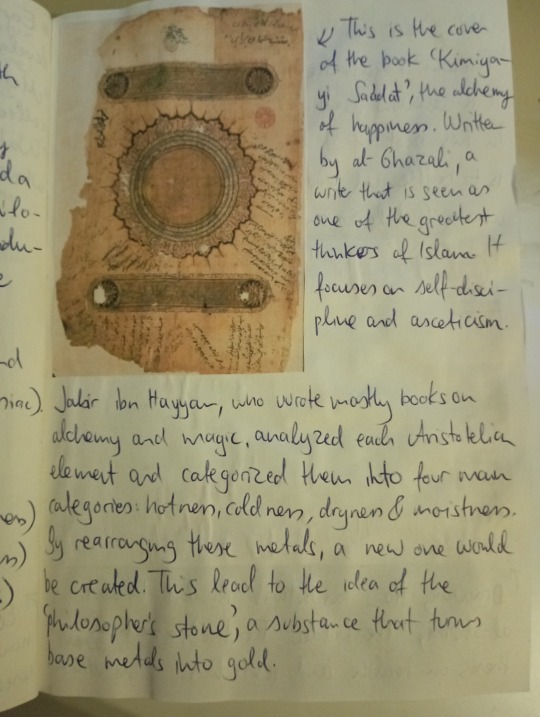
Transcript of the eighth and ninth page:
Arab alchemy is probably the most known one. The most popular alchemist was Muhammad ibn Zakariys Al-Razi. He said "the study of philosophy could not be considered complete, and a learned man could not be called a philosopher, until he has succeeded in producing the alchemical transmutation". He was a physician living in Bagdad and he classified metals as "bodies" and "spirits". There are several al-kimiya (meaning "wisdom") in the Arab world:
kimiya al-sa´ada (way of obtaining happiness)
kimiya al-ghama (way of obtaining richness)
kimiya alqulub (way of touching hearts)
Jabir ibn Hayyan who mostly wrote books on alchemy and magic analized each Aristotelian element and categorized them: hotness, coldness, dryness and moistness. By rearrangng these base metals a new one would be created, whicht hen gave birth to the idea of a "philosopher's stone", a substance that turns base metals into gold.
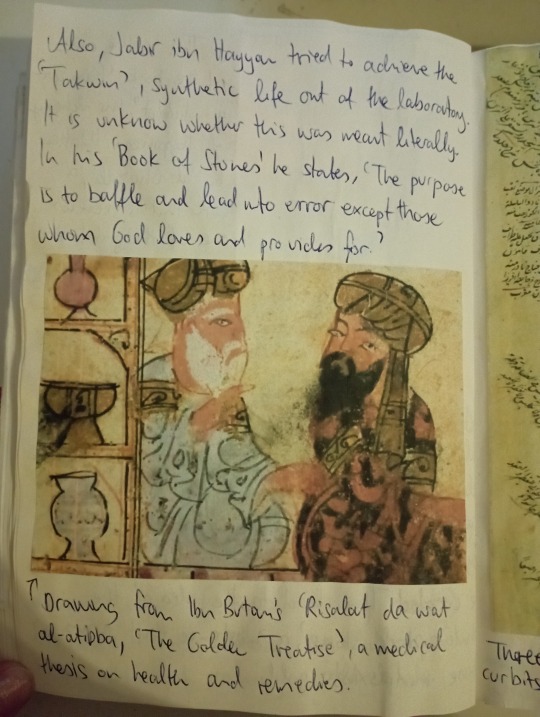
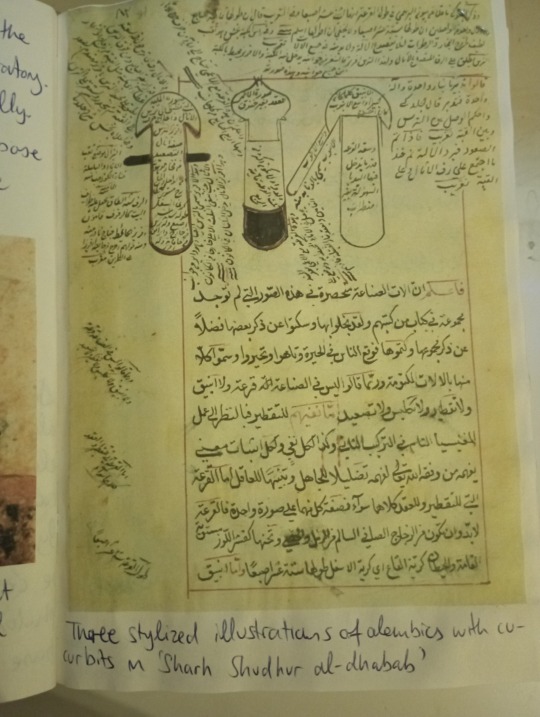
Transcript of the tenth and eleventh page:
Also, Hayyan tried to achieve the so-called "Takwin", synthetic life. It is unknown if this weas meant literally. In his "Book of Stones" he states "The purpose is to baffle and lead into error except those whom God loves and provides for." Next is an example of a page that contains glass test tubes like we know today.
I find the idea of creating a synthetic human terrifying and interesting as well as unnecessary, yet it caught my attention so bad I am currently analyzing a paper by Kurmo Konsa, a professor of history and archeology. He might answer my mail, too. Could one reawaken the nephilim if desired? Whatever. I have this to wait for...and Carvier's diary pages are still next to me.
#tomb raider angel of darkness#traod#classic tr#tomb raider#angel of darkness#journal#aod#lara craft#tomb raider series
5 notes
·
View notes
Text
CHAPTER I A SHIFTING REEF
The year 1866 was signalised by a remarkable incident, a mysterious and puzzling phenomenon, which doubtless no one has yet forgotten. Not to mention rumours which agitated the maritime population and excited the public mind, even in the interior of continents, seafaring men were particularly excited. Merchants, common sailors, captains of vessels, skippers, both of Europe and America, naval officers of all countries, and the Governments of several states on the two continents, were deeply interested in the matter.
For some time past, vessels had been met by “an enormous thing,” a long object, spindle-shaped, occasionally phosphorescent, and infinitely larger and more rapid in its movements than a whale.
The facts relating to this apparition (entered in various log-books) agreed in most respects as to the shape of the object or creature in question, the untiring rapidity of its movements, its surprising power of locomotion, and the peculiar life with which it seemed endowed. If it was a cetacean, it surpassed in size all those hitherto classified in science. Taking into consideration the mean of observations made at divers times,—rejecting the timid estimate of those who assigned to this object a length of two hundred feet, equally with the exaggerated opinions which set it down as a mile in width and three in length,—we might fairly conclude that this mysterious being surpassed greatly all dimensions admitted by the ichthyologists of the day, if it existed at all. And that it did exist was an undeniable fact; and, with that tendency which disposes the human mind in favour of the marvellous, we can understand the excitement produced in the entire world by this supernatural apparition. As to classing it in the list of fables, the idea was out of the question.
On the 20th of July, 1866, the steamer Governor Higginson, of the Calcutta and Burnach Steam Navigation Company, had met this moving mass five miles off the east coast of Australia. Captain Baker thought at first that he was in the presence of an unknown sandbank; he even prepared to determine its exact position, when two columns of water, projected by the inexplicable object, shot with a hissing noise a hundred and fifty feet up into the air. Now, unless the sandbank had been submitted to the intermittent eruption of a geyser, the Governor Higginson had to do neither more nor less than with an aquatic mammal, unknown till then, which threw up from its blow-holes columns of water mixed with air and vapour.
Similar facts were observed on the 23rd of July in the same year, in the Pacific Ocean, by the Columbus, of the West India and Pacific Steam Navigation Company. But this extraordinary cetaceous creature could transport itself from one place to another with surprising velocity; as, in an interval of three days, the Governor Higginson and the Columbus had observed it at two different points of the chart, separated by a distance of more than seven hundred nautical leagues.
Fifteen days later, two thousand miles farther off, the Helvetia, of the Compagnie-Nationale, and the Shannon, of the Royal Mail Steamship Company, sailing to windward in that portion of the Atlantic lying between the United States and Europe, respectively signalled the monster to each other in 42° 15′ N. lat. and 60° 35′ W. long. In these simultaneous observations they thought themselves justified in estimating the minimum length of the mammal at more than three hundred and fifty feet, as the Shannon and Helvetia were of smaller dimensions than it, though they measured three hundred feet over all.
Now the largest whales, those which frequent those parts of the sea round the Aleutian, Kulammak, and Umgullich islands, have never exceeded the length of sixty yards, if they attain that.
These reports arriving one after the other, with fresh observations made on board the transatlantic ship Pereire, a collision which occurred between the Etna of the Inman line and the monster, a procès verbal directed by the officers of the French frigate Normandie, a very accurate survey made by the staff of Commodore Fitz-James on board the Lord Clyde, greatly influenced public opinion. Light-thinking people jested upon the phenomenon, but grave practical countries, such as England, America, and Germany, treated the matter more seriously.
In every place of great resort the monster was the fashion. They sang of it in the cafés, ridiculed it in the papers, and represented it on the stage. All kinds of stories were circulated regarding it. There appeared in the papers caricatures of every gigantic and imaginary creature, from the white whale, the terrible “Moby Dick” of hyperborean regions, to the immense kraken whose tentacles could entangle a ship of five hundred tons, and hurry it into the abyss of the ocean. The legends of ancient times were even resuscitated, and the opinions of Aristotle and Pliny revived, who admitted the existence of these monsters, as well as the Norwegian tales of Bishop Pontoppidan, the accounts of Paul Heggede, and, last of all, the reports of Mr. Harrington (whose good faith no one could suspect), who affirmed that, being on board the Castillan, in 1857, he had seen this enormous serpent, which had never until that time frequented any other seas but those of the ancient “Constitutionnel.”
Then burst forth the interminable controversy between the credulous and the incredulous in the societies of savants and the scientific journals. “The question of the monster” inflamed all minds. Editors of scientific journals, quarrelling with believers in the supernatural, spilled seas of ink during this memorable campaign, some even drawing blood; for, from the sea-serpent they came to direct personalities.
For six months war was waged with various fortune in the leading articles of the Geographical Institution of Brazil, the Royal Academy of Science of Berlin, the British Association, the Smithsonian Institution of Washington, in the discussions of the “Indian Archipelago,” of the Cosmos of the Abbé Moigno, in the Mittheilungen of Petermann, in the scientific chronicles of the great journals of France and other countries. The cheaper journals replied keenly and with inexhaustible zest. These satirical writers parodied a remark of Linnæus, quoted by the adversaries of the monster, maintaining “that nature did not make fools,” and adjured their contemporaries not to give the lie to nature, by admitting the existence of krakens, sea-serpents, “Moby Dicks,” and other lucubrations of delirious sailors. At length an article in a well-known satirical journal by a favourite contributor, the chief of the staff, settled the monster, like Hippolytus, giving it the death-blow amidst an universal burst of laughter. Wit had conquered science.
During the first months of the year 1867 the question seemed buried, never to revive, when new facts were brought before the public. It was then no longer a scientific problem to be solved, but a real danger seriously to be avoided. The question took quite another shape. The monster became a small island, a rock, a reef, but a reef of indefinite and shifting proportions.
On the 5th of March, 1867, the Moravian, of the Montreal Ocean Company, finding herself during the night in 27° 30′ lat. and 72° 15′ long., struck on her starboard quarter a rock, marked in no chart for that part of the sea. Under the combined efforts of the wind and its four hundred horse-power, it was going at the rate of thirteen knots. Had it not been for the superior strength of the hull of the Moravian, she would have been broken by the shock and gone down with the 237 passengers she was bringing home from Canada.
The accident happened about five o’clock in the morning, as the day was breaking. The officers of the quarter-deck hurried to the after-part of the vessel. They examined the sea with the most scrupulous attention. They saw nothing but a strong eddy about three cables’ length distant, as if the surface had been violently agitated. The bearings of the place were taken exactly, and the Moravian continued its route without apparent damage. Had it struck on a submerged rock, or on an enormous wreck? they could not tell; but on examination of the ship’s bottom when undergoing repairs, it was found that part of her keel was broken.
This fact, so grave in itself, might perhaps have been forgotten like many others if, three weeks after, it had not been re-enacted under similar circumstances. But, thanks to the nationality of the victim of the shock, thanks to the reputation of the company to which the vessel belonged, the circumstance became extensively circulated.
The 13th of April, 1867, the sea being beautiful, the breeze favourable, the Scotia, of the Cunard Company’s line, found herself in 15° 12′ long. and 45° 37′ lat. She was going at the speed of thirteen knots and a half.
At seventeen minutes past four in the afternoon, whilst the passengers were assembled at lunch in the great saloon, a slight shock was felt on the hull of the Scotia, on her quarter, a little aft of the port-paddle.
The Scotia had not struck, but she had been struck, and seemingly by something rather sharp and penetrating than blunt. The shock had been so slight that no one had been alarmed, had it not been for the shouts of the carpenter’s watch, who rushed on to the bridge, exclaiming, “We are sinking! we are sinking!” At first the passengers were much frightened, but Captain Anderson hastened to reassure them. The danger could not be imminent. The Scotia, divided into seven compartments by strong partitions, could brave with impunity any leak. Captain Anderson went down immediately into the hold. He found that the sea was pouring into the fifth compartment; and the rapidity of the influx proved that the force of the water was considerable. Fortunately this compartment did not hold the boilers, or the fires would have been immediately extinguished. Captain Anderson ordered the engines to be stopped at once, and one of the men went down to ascertain the extent of the injury. Some minutes afterwards they discovered the existence of a large hole, of two yards in diameter, in the ship’s bottom. Such a leak could not be stopped; and the Scotia, her paddles half submerged, was obliged to continue her course. She was then three hundred miles from Cape Clear, and after three days’ delay, which caused great uneasiness in Liverpool, she entered the basin of the company.
The engineers visited the Scotia, which was put in dry dock. They could scarcely believe it possible; at two yards and a half below water-mark was a regular rent, in the form of an isosceles triangle. The broken place in the iron plates was so perfectly defined that it could not have been more neatly done by a punch. It was clear, then, that the instrument producing the perforation was not of a common stamp; and after having been driven with prodigious strength, and piercing an iron plate 1-3/8 inches thick, had withdrawn itself by a retrograde motion truly inexplicable.
Such was the last fact, which resulted in exciting once more the torrent of public opinion. From this moment all unlucky casualties which could not be otherwise accounted for were put down to the monster. Upon this imaginary creature rested the responsibility of all these shipwrecks, which unfortunately were considerable; for of three thousand ships whose loss was annually recorded at Lloyd’s, the number of sailing and steam ships supposed to be totally lost, from the absence of all news, amounted to not less than two hundred!
Now, it was the “monster” who, justly or unjustly, was accused of their disappearance, and, thanks to it, communication between the different continents became more and more dangerous. The public demanded peremptorily that the seas should at any price be relieved from this formidable cetacean.
5 notes
·
View notes
Text
The White Tiger Book Review
The White Tiger by Aravind Adiga is a satirical, political commentary that shows the bottom-up perspective of those who reside in the underbelly of India. In this case ‘Balram Halwai’ is the main protagonist, who on face value is an unremarkable, lower-caste, rural villager stuck in the chokeholds of the unforgiving hierarchical system of India. Adiga sets about his satirical view of India, by consciously writing out an allegory that employs multiple motifs and metaphors to cartograph India as a land of pre-determined hope or despair. The main crux of the allegory – the Rooster Coop – is a metaphor used to describe the oppression of the elite brought upon India’s destitute, which is only then perpetuated by the poor themselves out of entrenched poliical and cultural subordination. Adiga paints Balram Halwai as the exception, the one who breaks out of this cycle of oppression; however, he loses his moral fabric in exchange.
The book is composed as a letter to the Chinese Premier in Beijing, Wen Jiabao, who is addressed to the ironically named “Capital of the Freedom-loving Nation of China”. The main character, Balram, attempts to write out an exposé of the ‘real India’, almost akin to a whistle-blower stripping back the glossy façade to reveal an ugly and ruthless inside. A way in which Adiga attempts is through the use of the motifs of “Darkness” and “Light”. Balram explains how he was born in the “Darkness” and that “India is two countries in one”. Balram’s identification of the ocean brings ‘light’ to the “well off”, but where he resides is along the path of the “Black River” – the “river of death” which suffocates and stunts every “plant” that is grown there. Politically speaking, Adiga could be attempting a criticism of the various degrees of unequal social mobility. Although the Indian Constitution promises liberty and freedom, and anyone can effectively move to the ‘light’, India does not recognize the dire need for equity in these rural areas. The suffocating and stunted plants near the river are symbolic and representative of the people who reside within these rural and cut-off areas, they are not able to flourish on the social ladder or reach the full potential that lies ahead of them. The “black” and “sticky” river that “traps” is indicative of the pre-determined nature of these people and their inability to thrive in the conditions they find themselves in. The “river”, symbolic of the system – the lifeline - itself has failed them from the ground up. This sets a profound precedent in which Balram at first feels institutionalized in his fixed position in society.
This of course opens a psychological discourse of the dichotomy between ‘free will’ and ‘determinism’, another competing source of political misfortune in India, which Balram is symbolic of escaping from, the exception in the cycle of oppression. The caste system is front and centre to this dichotomy, with Balram admitting ‘my caste – my destiny”. Where caste was once a complex system of entrenched hierarchies, which the British Raj reinforced to classify the population, Balram believes he is now living in a simpler time of caste system: “men with big bellies and men with small bellies”. The White Tiger’s exploration of caste again takes a satirical turn in this way, as we can interpret this as the advent of global capitalism, simplifying hierarchy into means of consumption, what we have and what we don’t and of course the means of production. Balram and his family are subordinated to the upper-caste landlords, the ‘Animals’, which terrorize the village over their control of the agricultural land and therefore their means to a living. Politically speaking we can talk about the threat of democratic backsliding in India, but the idea of liberal democracy itself is but an abstract image in the eyes of the destitute, many of whom are trapped within the ‘Rooster Coop’ with the fences of caste and wealth disparity paralyzing them. The idea of a pre-determined fate in India is all too prevalent. The character of Ashok, the wealthy son of the Stork, is a reluctant but accountable individual in bribing corrupt politicians for leverage. Like the motif of the “black river” before, the source that Indians look to for benevolence has been poisoned and corrupted in the pursuit of the capitalist interests of the few – the most contemporary representation of this being the mass Farmer's Protest.
Balram’s escape from the ‘Rooster Coop’ is an idealization of freedom. Balram spits on the ground as he sees his village from afar, where the abandoned Black Fort represents the mystical and colonial past, his vantage point points toward the landlord’s mansion, a source of burden and heavy taxation, and the “glistening line of sewage” – representative of the rural degradation villages suffer as a source of egregious extraction and plunder. This harks back to the British Raj where only the upper-class elite was granted immunity from the harsh realities of imperialism. Balram’s escape from this is then remarkable, he is trapped under the remnants of a feudal system, and therefore his steps towards freedom would not be without consequence – losing his family as a safety net, but also not being there as a source of income for them anymore.
The White Tiger, although an escape from the true grounded realities of India, is still a profound satirical representation of India. The allegory of the ‘Rooster Coop’ is a constant throughout the book, which highlights the institutionalization of oppression itself within the poor, highlighting the lack of a means to social mobility whilst also subordinated by hierarchical social forces. Balram Halwai, the ‘White Tiger’, himself is a unique individual within a story of symbolic caricatures who represent the elite. Balram having to kill his ‘oppressor’ to ultimately emulate the capitalist elite he was subordinated under is ironic within itself and ultimately serves as a lesson in the perpetual cycle of oppression that is the ‘Rooster Coop’ – it is harrowingly “eat or get eaten up”.
Bibliography
Adiga, A., 2008. The White Tiger. 2nd ed. London: Atlantic Books.
#book blog#book review#the white tiger#aravind adiga#marxism#political economy#india#indian politics#indian literature#caste system
7 notes
·
View notes
Text
Best Newspaper Advertising Agency in Noida

Srishtisutra is the Best Newspaper Advertising Agency in Noida. In the field by re-bundling abilities like creative, strategy, and media for specific demands, we help our clients establish a united and consistent marketplace. There is no denying that newspapers have a significant impact on our everyday life. Everywhere in the world, people read the morning newspaper. It is well known that even the introduction of the internet has influenced just enhancing advertising. Newspaper advertising gets readers' full attention without distracting them. Although it has completely changed every area of our daily lives, the newspaper will always be the best option for advertising since it has a big audience and gives credibility, dependability, and accessibility. Srishtisutra is the Best Newspaper Advertising Agency in Noida that, from strategy to execution, writes, produces, generates, and distributes inspirational material for every area, range, and screen. That is what sets us apart from the bulk of newspaper advertising companies that specialise in particular domains. Each organisation receives a unique set of newspaper advertising services from us, ensuring the greatest outcomes every time. Our competence is in the original methods we employ to change our clients' businesses. Furthermore, we think that rather than just coming up with ideas, organisations should create amazing tales that keep customers interested throughout. As a marketing firm, we have a long history of dealing with all Indian media. We have expertise in newspaper advertising and have developed effective solutions to difficulties associated with newspaper advertising throughout India.
We have compiled extensive advertising information to help you analyse newspaper advertising costs, verify possible discount packages, check circulation figures, and much more. Srishtisutra is the Best Newspaper Advertising Agency in Noida that helps customers make informed media purchases. Advertising in all major Indian newspapers may now be booked online at the lowest ad rates. The most prevalent sorts of advertisements in newspapers are display ads and classified ads. A newspaper's audience and page number have an impact on ad price. Advertising on the front page of a newspaper is more expensive than typical newspaper advertisements. Small businesses are advertised in the newspaper's classified section. Advertising on classified ad paper is less expensive than advertising on display ad paper. A newspaper advertising agency sells the vast bulk of newspaper advertisements in India. We provide our clients with the most affordable newspaper advertising rates. We understand your objectives and recommend the best newspaper to advertise in based on our extensive advertising experience. Because the cost of a newspaper advertisement is often determined by circulation, you may compare the cost of a newspaper advertisement to circulation figures for each region on our website. This will allow you to make an informed selection and effectively reach out to your customers. Believability, as a great man once remarked, is "the finest thing to be done in advertising, in my opinion," and we follow it with full ritual to delight our consumers.
#newspaper advertising agency#best newspaper advertising agency#newspaper ad agency#newspaper advertisment
2 notes
·
View notes